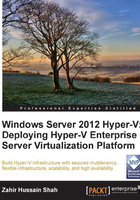
Why virtualization?
An organization that doesn't follow the latest trend of virtualizing its server workloads will often see its existing hardware investment as under utilized from the resource utilization prospective. This means a majority of physical hardware boxes don't reach to their capacity even twice a month. These under-utilized hardware boxes utilize rack space, cooling, power, and most importantly annual server maintenance cost if your server is out of the supplier's original warranty of 3 years.
The notion of virtualization allows us to consolidate multiple workloads on a single server, which ensures that existing server hardware investment gets fully utilized. This concept also supports the green IT slogan where the IT department tries to save power, cooling, as well as space to maintain the same level of service delivery but with less utilization of these natural resources. Often we see it is difficult to scale in and scale out an application server running on a physical server, while on the other side with the help provided by virtualization, we can scale in and scale out an application very easily. This helps an administrator to dynamically increase the resources for a virtual machine whenever it is needed; with the help of a server virtualization management platform, such as SCVMM we can even automate this. So whenever the hypervisor comes to know that there is more load, it can dynamically add more instances of an application, and when there is no load, the same extra provisioned instances get removed from the environment on the fly.
Let's try to simplify this question of why virtualization is needed by laying out few of the reasons, which immensely strengthen the need for virtualization:
- Among all other benefits of virtualization the most exciting benefits an organization gets from it, are server consolidation and cost reduction. This means an organization can run multiple different IT application systems on a single hardware server, where without virtualization it has to have dedicated hardware equipment for these multiple application instances, which means a larger required amount of rack space, cooling, power, and associated maintenance cost has to be paid for. On the flip side, without virtualization, the majority of the server systems run in an under-utilized state, which means the organization cannot get the most from its investments, where by utilizing virtualization it can use its systems to their maximum capacity.
- Virtualization allows an organization to run its legacy application systems on the latest hardware. This reduces the extra burden to maintain the old server equipment, which is out of warranty and is very expensive to maintain due to the unavailability of service and spare parts.
- Being an IT professional, virtualization is like an old school buddy who helps you learn and always be on top of new technologies and expertise. With virtualization it is much easier to build a research and development environment again and again. And by using a virtual machine, we can build a new server along with OS installed in just a minute. As we all know, testing requires us to build various test cases where rebuilding the same environment is needed from time to time, so virtualization helps you save your time and get things done in a much easier way.
- Virtualization is one of the methods for converting a physical machine to a virtual machine, which allows you to maintain the existing physical server operating system settings and convert it into a virtual machine. Usually, this gets done when there is an old hardware server on which you are running an application, which you would like to run on a virtual machine, but you don't want to install from the scratch and want to maintain the existing configuration. So in this case all we need to do is to perform the conversion and we can run the same application as a virtual machine with everything untouched.
- Another essential reason why virtualization is needed in our datacenter is that, with virtualization, applying dynamics and optimization becomes much easier. As we mentioned previously, with some sort of virtualization orchestration and management tools you can configure real-time dynamics for applications to scale out and scale in whenever there is a load for application. And virtualization as a base layer provides the computing platform for these dynamically expending application platforms.